“Without the two-hour delay, little Mabruk, ‘good luck’ in Arabic, might have been born on the military ship. The baby saw the light of our world for only a few minutes. In the face of that extreme delivery, Ola Mouaffek Shihab Eddin, 32 years old, a pediatrician, and Naya Raslan, around the same age, a gynecologist, did not falter in their duty and descended into the belly of the fishing boat. Mabruk is now eighty meters at the bottom of the sea, in the arms of his young mother, with the two doctors beside them.”
(Fabrizio Gatti – L’Espresso – November 7, 2013)
“In Requiem Mediterraneo, Mabruk, his young mother, and the many victims of that terrible shipwreck ideally come back to life, rise from the bottom of the sea, and walk toward Europe to demand justice. They point their finger at us, at our inadequate regulations, at the inertia of our actions; they turn to God not only to be welcomed but also to be avenged in a biblical sense. I wrote and conceived this music to tell the story of the present, to tear Mabruk’s story from the virtual world – from news that, in a certain sense, remains beyond the screen – and bring it back to a context of reality. Mabruk is a child of all of us.”
(Sebastiano Cognolato)
Requiem Mediterraneo
In memory of the migrants who perished on the routes of our sea
Requiem Mediterraneo is a scenographic missa pro defunctis dedicated to the migrants who lose their lives trying to reach the Italian shores. It was first staged on October 3, 2021, at the Triennale Teatro dell’Arte in Milan, under the patronage of the United Nations High Commissioner for Refugees (UNHCR), the Municipality of Milan, and Fondazione Cariplo.
The work is inspired by a key moment in the recent history of our sea. On October 11, 2013, over 260 migrants, including about 150 children, drowned because the boat they were on (which had left from the Libyan coast and was shot at by the Libyan coast guard) sank after drifting for hours, despite numerous calls for help being received by the Italian and Maltese navies. The tragedy of the children came to light thanks to an investigation by journalist Fabrizio Gatti: in 2021, the Italian state was found guilty of failing to provide assistance by the United Nations.
The dramatic structure of the work contrasts the two main elements, the piano and the choir, with the choir representing the migrants and the piano symbolizing the Western world.
The canonical form of the missa pro defunctis is interwoven with texts drawn from real-life events, including the identities of the migrants and their pleas for help to the Italian authorities.
The Choir
The choral ensemble is divided into two sections: the musical choir, placed off-center on the stage (to the side or back), fulfilling the function of a traditional choir, and the scenic choir, composed of choristers and mime/extra performers who serve both choreographic and musical purposes on stage.
The work opens with the choristers lying on the stage. Their bodies are lifeless, dressed in torn clothes.
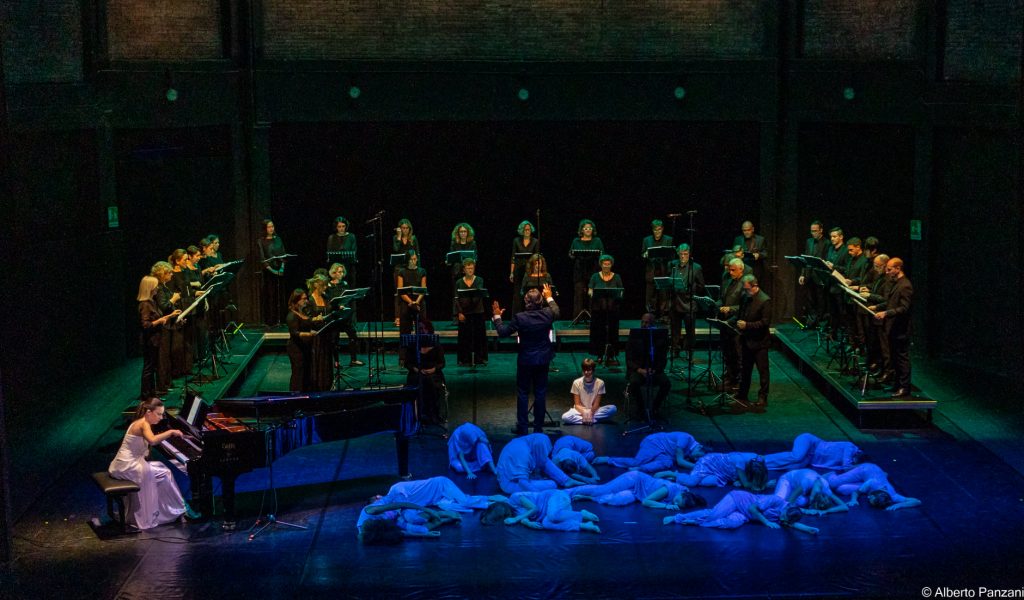
After the Requiem aeternam, in which the choristers embody the lost migrants by whispering their names and surnames, the singers slowly rise and throughout the performance approach the piano and the audience menacingly. Gradually, they occupy all the available physical and acoustic space; they crowd around the piano’s body, the keyboard, and the pianist, touch the strings, the keys, and invade the audience, eventually engulfing the instrument and the spectators in the final scene (Psalm 58).
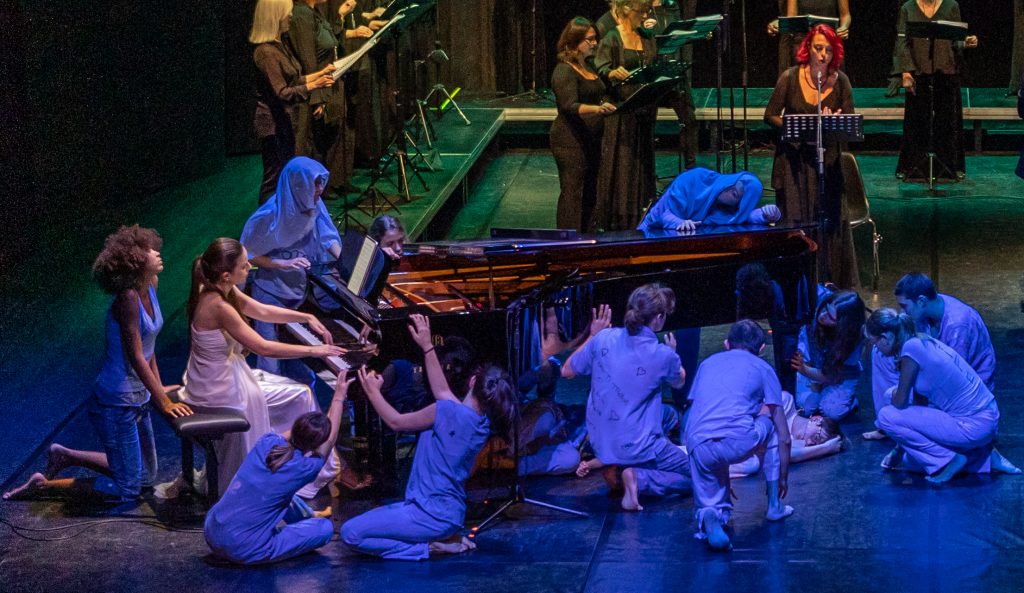
The movements, specific to each chorister and precisely described in the score, are slow and awkward (as if human bodies were walking underwater).
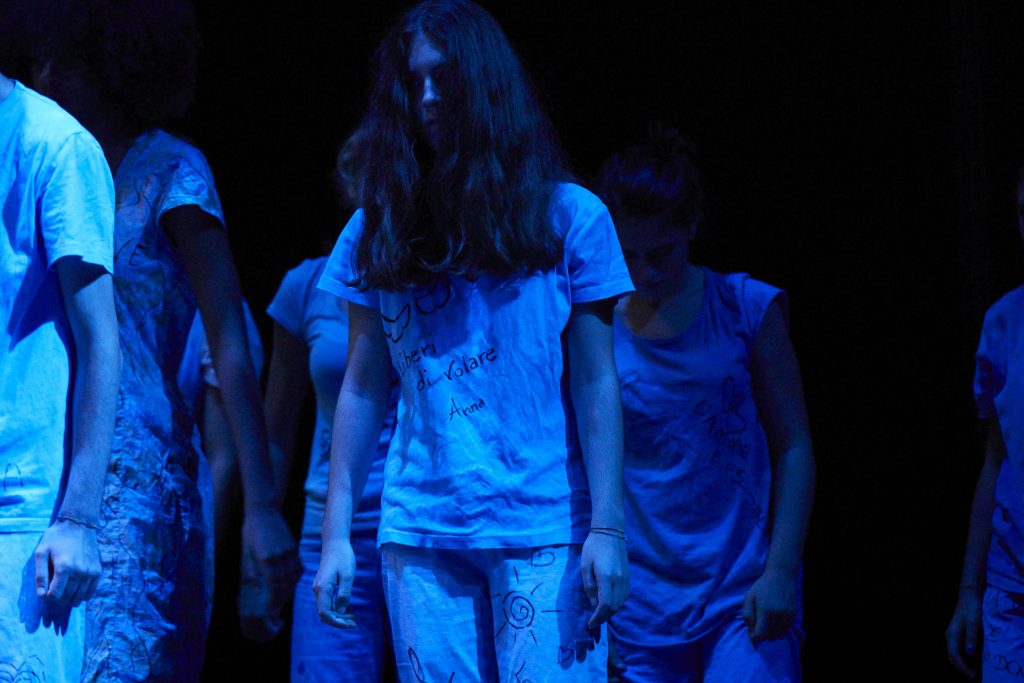
The score includes concrete effects for the vocal parts, timbral plays, rhythmic sections, and the spontaneous use of unconventional techniques: in addition to singing, the choir members whisper, shout, blow, strike objects, and intervene on the parts of the piano.
The Piano
Requiem Mediterraneo stems from Mabrouk, a music-document composed by Sebastiano Cognolato in 2018, commissioned by Spazio Teatro 89. The piano part of the Requiem continues the characteristics of bodily expressiveness typical of Mabrouk and further develops them through the relationship with sacred texts and the choir.
Pianist Fernanda Damiano plays with the energy and movement of her whole body, sings parts of the requiem, and completely surrenders herself to the music, becoming submerged by it. She is contrasted with the choir from the very beginning and succumbs in the finale. She wears a white, almost bridal gown that evokes purity, embodying the triple role of officiant of the requiem, symbol of the Western world, and sacrificial lamb.
Premiere, Triennale Milano Teatro, October 3, 2021
Under the patronage of the United Nations High Commissioner for Refugees (UNHCR)
Under the patronage of the Municipality of Milan
Under the patronage of Fondazione Cariplo
With the participation of the spontaneous energies of the city
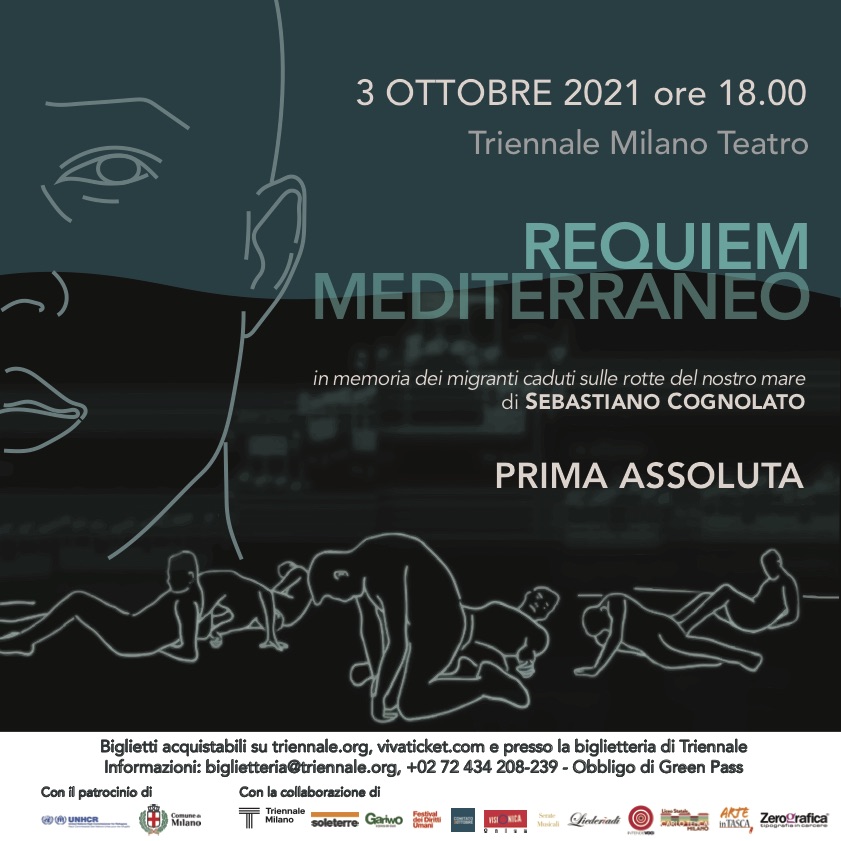
“Deeply moved, struck, and shaken by the expressive power of Requiem Mediterraneo. And grateful to the author, Sebastiano Cognolato, for offering an example of how theater can truly be a community and a place for reflection. It shows how giving aesthetic form to the most dramatic events of our time doesn’t distort the analysis or sugarcoat the perception but rather helps us avoid denial and self-absolution. My gratitude extends to all the performers: pianist Fernanda Damiano, a steel flower whose clusters shook like terrifying waves; the intense and heartfelt voices of Valentina Coladonato, Blagoj Nacoski, and the very young Giovanni Crisostomo; and the marvelous Intende voci Chorus, perfectly prepared and passionately led by Mirko Guadagnini. Let’s not forget the students from Liceo Tenca, who served as mimes, and the ever-excellent Silvio Oggioni, who crafted the essential but highly effective direction of the show. Thank you, thank you, thank you! It was a fortune to hear you and a joy to applaud you.”
(Luca Schieppati – Facebook)
“I had recounted Mabrouk’s story in L’Espresso in 2013. Seven minutes of life, from birth to shipwreck. Requiem Mediterraneo, a work written by Sebastiano Cognolato, is dedicated to Mabrouk and all the victims of the sea and desert. On the Day of Remembrance and Welcome, tenor and conductor Mirko Guadagnini, pianist Fernanda Damiano, soprano Valentina Coladonato, tenor Blagoj Nacoski, director Silvio Oggioni, along with the friends from Bollate Prison and the students of Liceo Carlo Tenca in Milan, dedicated their art to the world premiere.”
(Fabrizio Gatti – Facebook)
“The endless tragedy of migrants at sea finds a voice in the music of Sebastiano Cognolato.”
(Daniela Zacconi – Vivimilano Corriere della Sera)
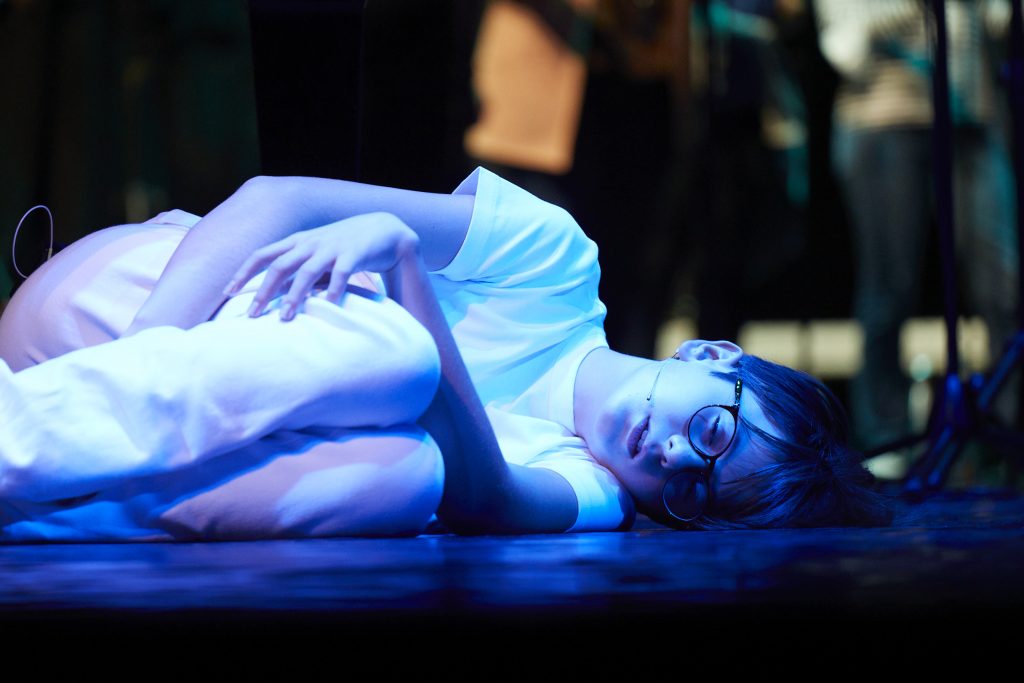
Artists and Partners
The first staging of Requiem Mediterraneo, under the patronage of the United Nations High Commissioner for Refugees (UNHCR), the Municipality of Milan, and Fondazione Cariplo, is born from the collaboration of various cultural associations, entities, and prominent artists: the Liederìadi Association, led by tenor and conductor Mirko Guadagnini and his Intende Voci Chorus; director and theater operator Silvio Oggioni; the expressive pianist Fernanda Damiano; soprano Valentina Coladonato; tenor Blagoj Nacoski; and the children’s voices of the Accademia Teatro alla Scala represented by Giovanni Crisostomo and Lavinia Galati. Other supporters and patrons include Triennale Teatro dell’Arte, Serate Musicali di Milano, Soleterre, Festival dei Diritti Umani, Gariwo, Comitato 3 Ottobre, Bollate Prison, Liceo Carlo Tenca, Visionica Onlus, Arte In Tasca, and Bollate Prison.
Behind the Staging: Contributions, Spontaneous Energies, and Pathways
Bollate Prison (MI)
The costumes worn by the scenic chorus were made by inmates at Bollate Prison through the Arte in Tasca workshop. The playbill and posters were printed at the Zerografica graphic workshop, also within the prison. The costumes bear signatures (phrases, tags, and free thoughts) from those who crafted them.
Liceo Carlo Tenca of Milan
The scenic chorus consists of students from Liceo Carlo Tenca of Milan, a European Parliament Ambassador School. The students will explore the themes of the opera through in-class studies.
Soleterre
In September 2021, the Soleterre Foundation promoted a crowdfunding campaign to finance the staging of Requiem Mediterraneo. The goal was exceeded both financially and in collective participation. Cartoonist Vauro also created a cartoon dedicated to the work.
Gariwo
To present and promote the premiere of Requiem Mediterraneo, on September 19, 2021, Gariwo organized a concert at the Garden of the Righteous in Milan with pianist Fernanda Damiano and fisherman Vito Fiorino, Righteous of the Mediterranean, who saved dozens of shipwreck victims with his fishing boat.
Rumors, Crowdfunding Campaign
“Beautiful initiative. Giving voice through a universal language like music to those who no longer have words.”
“Happy to support such an important cause.”
“Humanity is in great danger; we must be more supportive.”
“Beautiful project!”
“Good luck!!! I’m happy to contribute!”
“Interesting and powerful project, making voices heard on such a timely topic.”
“Migrants and the Afghan crisis must find a collective response by raising awareness.”
“Thank you ❤”
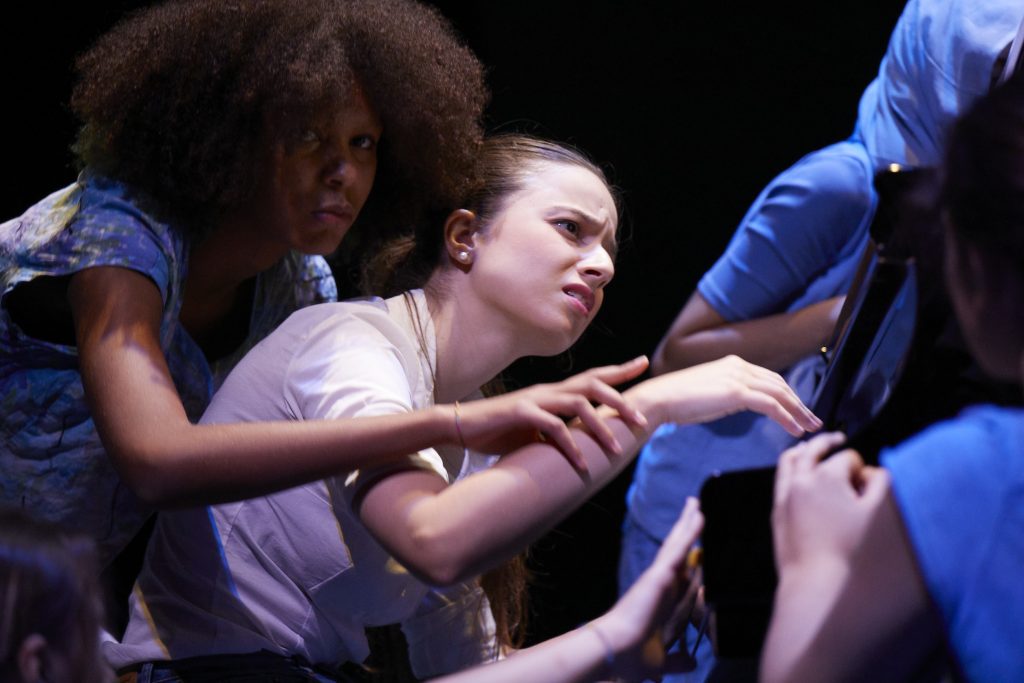
Other Synergies
The first performance of Requiem Mediterraneo was actively supported by: Festival dei Diritti Umani, Comitato Tre Ottobre, Visionica Onlus, Accademia Teatro alla Scala, and Serate Musicali.
Texts and Dramaturgical Notes
“In Requiem Mediterraneo (…), liturgical and scriptural passages are interwoven or interrupted by the names of migrants who perished at sea, fragments of the Dublin Regulation, frantic radio exchanges between boats and coast guards, and the clinical jargon of the Stockholm Programme. It is a carefully crafted collage of languages (Latin, English, Hebrew, Greek), styles (the weight of sacred texts, the hollow rhetoric of institutional propaganda), communication, and miscommunication. Its strength is also conveyed through the multimedia staging: the Requiem, once liturgical and oratorial, is now fully theatricalized, using multimedia to amplify its impact on the meditative audience.”
(Daniele Filippi – from the presentation booklet)
- Requiem Aeternam
- Dies Irae
- Dublin Regulation III
- Help Us
- Angele Dei
- Aμνὸς τοὺ θεοὺ (John 1:29)
- Stockholm Programme
- Psalm 12
- Lux Aeterna
- Psalm 58
1 – Requiem Aeternam
The scene opens in darkness, with the piano playing a broken and subdued melody. Gradually, the stage lights up, and the bodies of the deceased (scenic chorus) begin to move and pronounce their names. The musical chorus follows the piano’s broken song, intoning the requiem more and more audibly; the singers’ volume increases until it becomes a scream of horror and denunciation, opening Dies Irae.
Taghrid Muhriz, mother. Cham Muhriz, child. Yaman Aldin Sibaei, child. Raghad Aldin Sibaei, child. Homam Aldin Sibaei, child. Manal Eyoun, mother. Salah Aldin Sibaei, father. Mohamed Jafar Izoli, young man. Reem Shahada, mother. Abdulmagid Sheikh Mohamad, child. Mohamad Sheikh Mohamad, child. Lara Sheikh Mohamad, child. Bachira Kharnoub, mother. Fatena Khatib, mother. Joud Mustafa, child. Mayar Lababidi, child. Mnawer Raheel, father. Bisan Mnawer Raheel, child. Tharwat Al Tahan Alzaeem, mother. Oday Mussa, child. Shahada Mansour, father. Yaman Mansour, child. Mohamad Mansour, child. Nahawand Dahoud, mother. Riyad Khalifa Al Essa, father. Osama Al Essa, child. Ayman Al Essa, child. Tarek Al Essa, child. Maria Suliman Aldush, mother. Hussein Almahdi Alkhalifa, young man. Mohamad Khaled Al Haj, child. Raed Khaled Al Haj, child. Shirihan Hasan Seif, child. Nourhan Hasan Seif, child. Randa Hasan Seif, child. Salsabil Hasan Seif, child. Mohamad Abdunaser Slemani, child. Mohamad Samer Ali, child. Alma Maher Mustafa, child. Asmaa Burghol, mother. Mansour Emad Sheikh Mohamad Burghol, child. Abdulhamid Sheikh Mohamad, child. Hana Ahmad Alhosni, mother. Salim Alhosni, child. Nour Alhosni, child. Dima Alhosni, child. Hussam Alhosni, young man. Khaled Awad, father. Kenda Awad, child. Marwa Awad, child. Aldin Awad, child. Aylan Shenu, child. Mohamad Nour Almounezl, young man. Mohamad Jammo, child. Nahel Jammo, child. Mariam Atwa, woman. Amal Abdulnaser Sulemaini, woman. Doaa Atwa, woman. Ghada Dahsha, woman. Hadil Halboni, woman. Mayssa Abdulrahim Slemani, mother. Abdulrahman Slemani, woman. Lena Zakzak, woman. Bilal Ibrahim el Habib, man.
Requiem aeternam dona eis, Domine, et lux perpetua luceat eis; in memoria aeterna erit iustus ab auditione mala non timebit.
02 – Dies irae
The cry of God’s wrath overwhelms all the choristers. The stage choir strikes the stage with hands and feet; the choristers move more and more convulsively, trying to stand up. The Dies irae is interspersed with Dublin Regulation III and Help us, whose texts represent the sins judged on Judgment Day. The piano plays a rhythmic and expressive commentary through the use of differentiated choreographic clusters with elbows, forearms, and wrists.
Dies irae, dies illa Solvet seclum in favilla Teste David Cum Sybilla Quantus tremor est futurus, Quando Iudex est venturus, Cuncta stricte discussurus.
03 – Dublin Regulation III
The Dublin Regulation III, concerning the European destination of migrants, is referenced in brief rhythmic cells while the stage choir, in the dark, evokes the concrete disturbance noises of shortwave radios. The fragments are extrapolated according to a criterion of musical and dramatic expressiveness. The dynamics range from pianissimo (ppp) to mezzo-forte (mf).
Dublin Regulation Stockholm Programme Rights of the child Fundamental Rights Eurodac CEAS Interests of the child Social development Fundamental Freedoms Respect for family Compassionate grounds Mutual trust.
04 – Help us
In the same scene as Dublin Regulation III, excerpts from the triangulated phone transmissions between the sinking boat on October 11, 2013 (the children’s shipwreck) and the Italian and Maltese naval authorities, co-responsible for the deaths of most of the children, are included.
“Hello ok speak English, hello ok speak English 3 hundred persons on board You have departed from Zuara? Please hurry Are you moving, or are you stopped? We are moving by the wave I say to you we are in a very hurry, please, I’m a doctor, please What is the problem on board? The boat is going down Half a meter of water on board Ok, your name, your name My name is Mohamed Jammo, I’m a doctor Sir, repeat your position for another one. Your position North 34 2018, it’s the same. And East 12 42 05 Ok, thank you sir, thank you. Hello, please, did you send anyone for us? We are Syrians, about 300 Sir, I gave you the number of Malta authority. You are near Malta, did you understand me? Near Malta? We are near Malta? Yes sir, yes Sir, please go, go. Call Malta directly very quickly, and they are there, they are close, ok? I called Malta. They say that we are nearer to Lampedusa than to Malta. You are the proximity for us. We are dying, please! About 300, we are dying!”
05 – Angele Dei
One of the protagonists of the Requiem is Mabrouk, a baby born during the shipwreck of October 11, 2013 (see above) and who died minutes later. This scene, at the center of the opera, recalls him, with a child singing the Angele Dei of Catholic tradition. The piano counterpoints the melody sung by the child. Angele Dei connects directly to the next scene (Agnus Dei).
Angele Dei, Qui custos es mei, Me, tibi commissum Pietate superna, Illumina, custodi, Rege et guberna. Amen.
06 – Ἀμνὸς τοῦ θεοῦ (John I:29)
The child’s Angele Dei is overwhelmed by the violence of the sea and wind. The piano expressively describes the sinking of the boat and the child’s death. On stage, Mabrouk wanders in fear, pushed back and forth until he curls up in a fetal position under the piano. The musical choir accompanies the scene, shouting the verse from John I:29 (“Behold the Lamb of God who takes away the sins of the world”) in ancient Greek.
“ἴδε ὁ ἀμνὸς τοῦ θεοῦ ὁ αἴρων τὴν ἁμαρτίαν τοῦ κόσμου.”
07 – Stockholm Programme
In the central part of the Requiem, the stage action is suspended. The light focuses on the child’s body lying under the piano while the musical choir sings a cappella a text taken from the Stockholm Programme, concerning security, freedom, and justice in Europe, counterbalancing the actual behavior of individual European states. Some solo parts represent heads of state and political figures who have addressed or exploited the immigration issue in Europe in recent years.
Chapter one: Towards a citizens’ Europe in the area of freedom, security, and justice. Chapter two: A Europe of rights. Chapter three: A Europe of law and justice. Chapter four: A Europe that protects. Chapter five: Access to Europe in a globalized world. Chapter six: A Europe of responsibility, solidarity, and partnership in migration and asylum matters. Chapter seven: The external dimension of freedom, security, and justice.
08 – Psalm 12
The last three scenes are connected: in them, the chiasm that characterizes the opera’s dramaturgy is completed. The action resumes: the deceased are standing, slowly converging toward the piano. The text of the psalm is sung in the original Hebrew (in this presentation, the translation from the CEI into Italian is proposed).
“Save me, O Lord! There is no longer a faithful man; fidelity has vanished among the children of men. Everyone speaks falsehood to his neighbor; with flattering lips and a double heart they speak. May the Lord cut off all flattering lips, the tongue that boasts arrogantly, those who say, “With our tongues we prevail; our lips are our own—who is lord over us?” “Because the poor are plundered, because the needy groan, I will now arise,” says the Lord; “I will place him in the safety for which he longs.” The words of the Lord are pure words, like silver refined in a furnace on the ground, purified seven times. You, O Lord, will keep them; you will guard us from this generation forever. On every side the wicked prowl, as vileness is exalted among the children of men.”
09 – Lux Aeterna
The deceased are bathed in a blinding light and frozen in sculptural still-images; their arms raise to the sky and/or extend to embrace the audience.
Lux æterna luceat eis, Domine, Cum Sanctis tuis in æternum: quia pius es. Requiem æternam dona eis, Domine, et lux perpetua luceat eis. Cum Sanctis tuis in æternum: quia pius es.
10 – Psalm 58
The converging movement of the scenic choir tightens; with the imprecations of the psalm (verses 7-9), the piano and the pianist are overwhelmed, seized, and submerged by the bodies of the deceased, who place their hands on the keyboard, playing clusters on the keys, creating noises on the strings and the piano’s body, leaning in an unsettling and threatening way toward the audience, as if to engulf them. Mabrouk is lifted in someone’s arms and brought to the front of the stage, in choreography reminiscent of Caravaggio’s The Deposition, with a similar effect created by the positioning of the painting: the audience witnesses the scene as if looking from inside Christ’s tomb. The psalm’s text is sung in ancient Hebrew (in this presentation, the CEI translation in Italian is provided).
To the choirmaster: Do not destroy. A Miktam of David.
Do you indeed decree what is right, you gods?
Do you judge the children of man uprightly?
No, in your hearts you devise wrongs;
your hands deal out violence on earth.
The wicked are estranged from the womb;
they go astray from birth, speaking lies.
They have venom like the venom of a serpent,
like the deaf adder that stops its ear,
so that it does not hear the voice of charmers
or of the cunning enchanter.
O God, break the teeth in their mouths;
tear out the fangs of the young lions, O Lord!
Let them vanish like water that runs away;
when he aims his arrows, let them be blunted.
Let them be like the snail that dissolves into slime,
like the stillborn child who never sees the sun.
Sooner than your pots can feel the heat of thorns,
whether green or ablaze, may he sweep them away!
The righteous will rejoice when he sees the vengeance;
he will bathe his feet in the blood of the wicked.
Mankind will say, “Surely there is a reward for the righteous;
surely there is a God who judges on earth.”